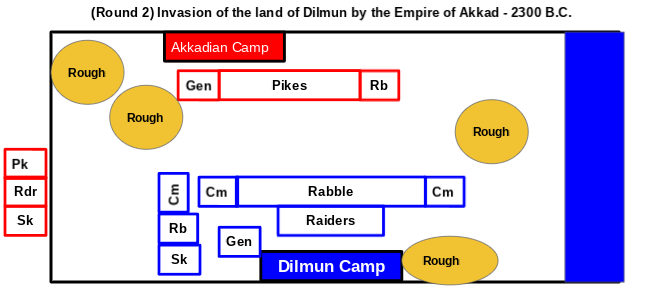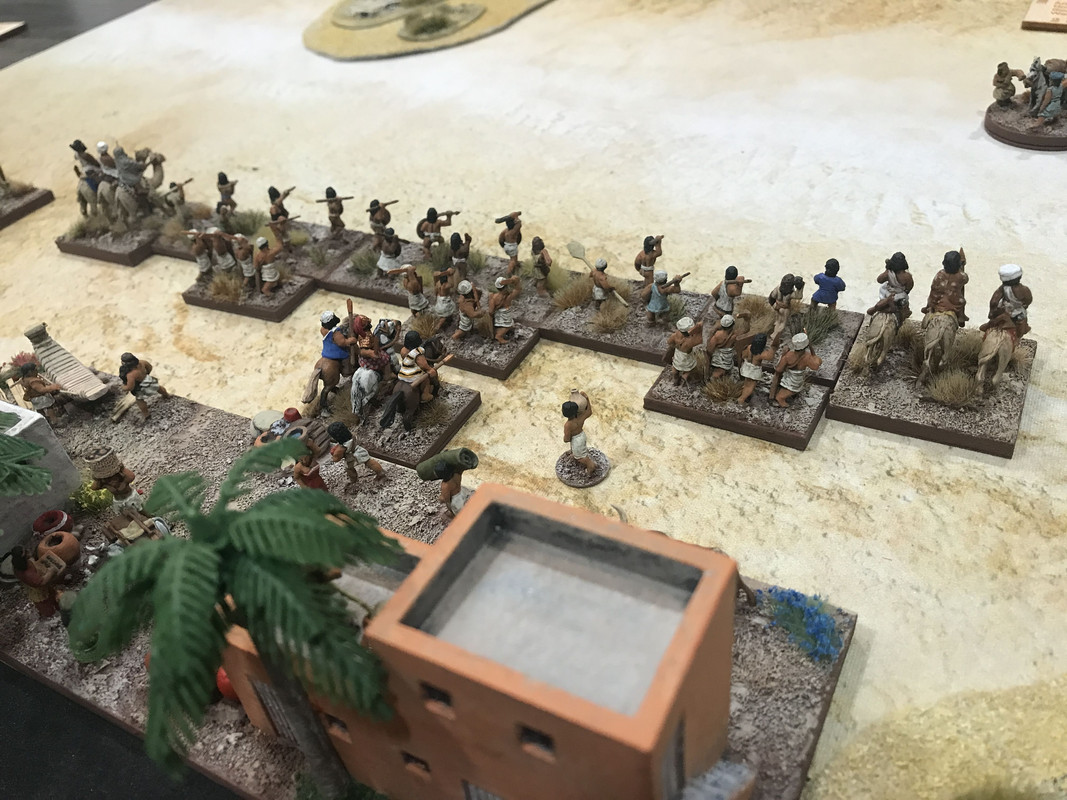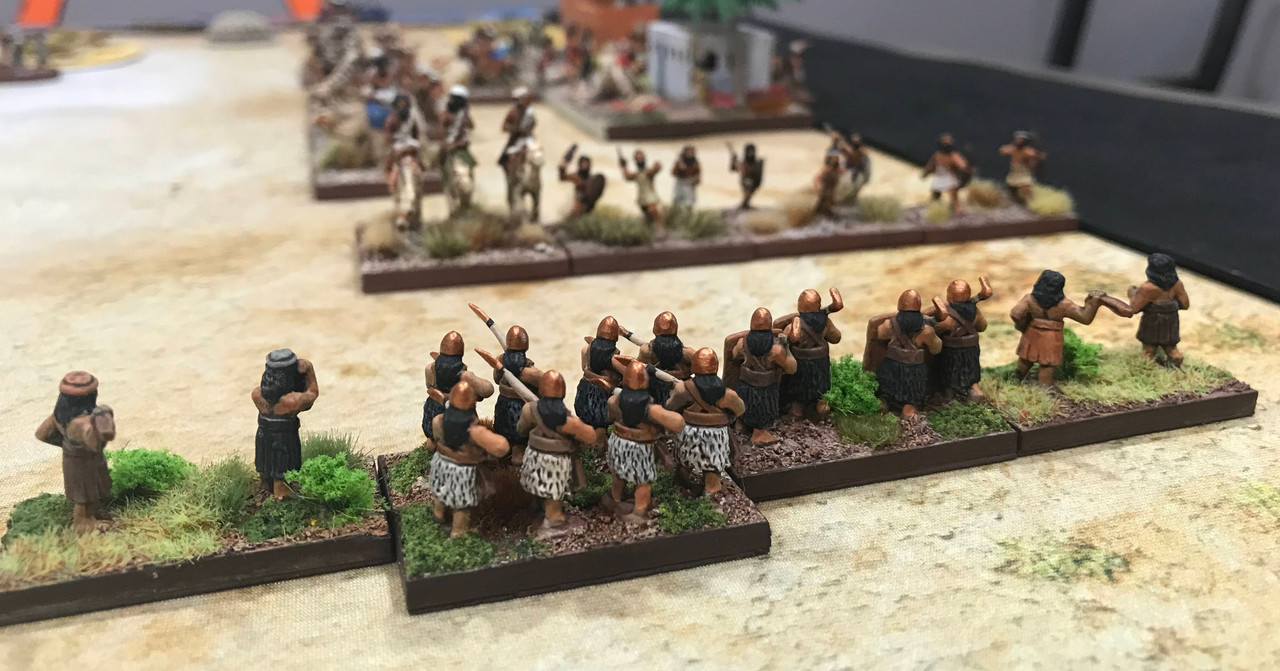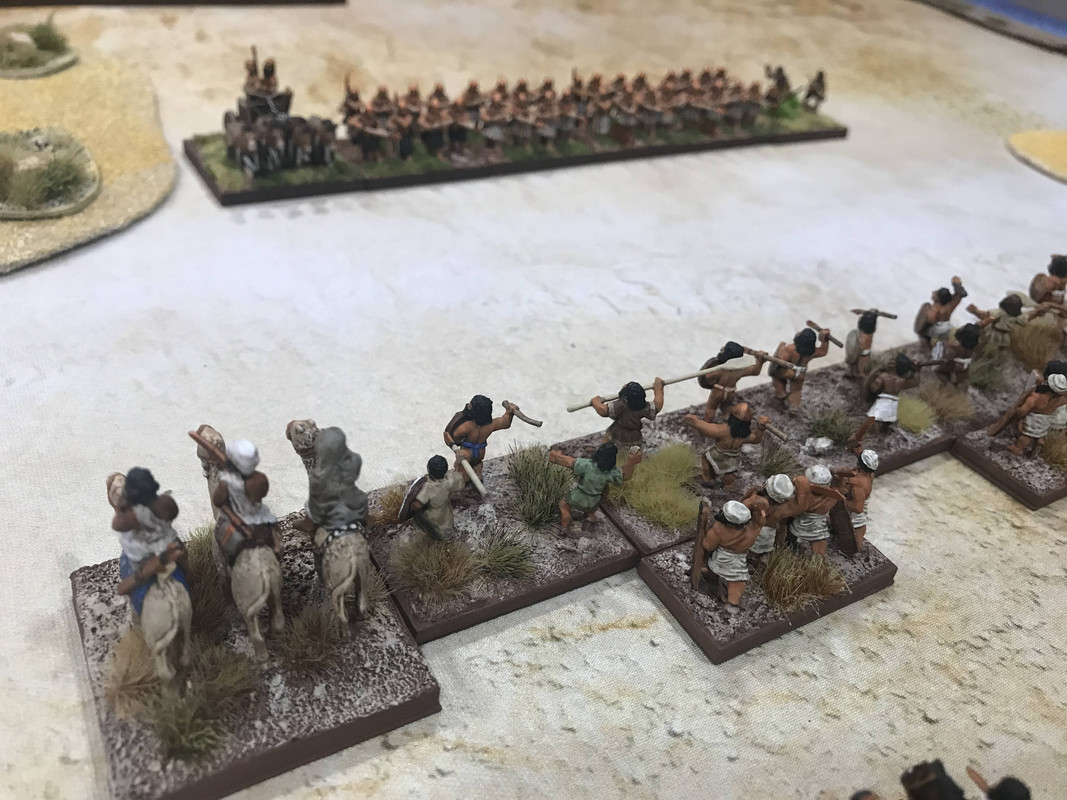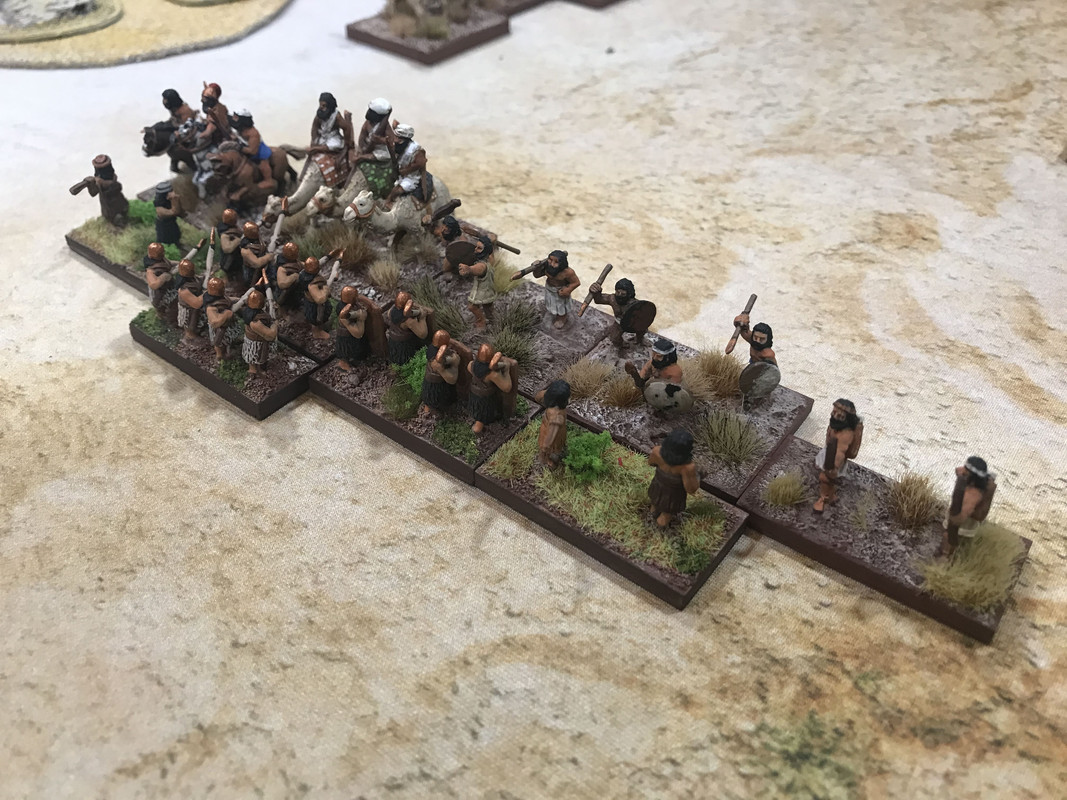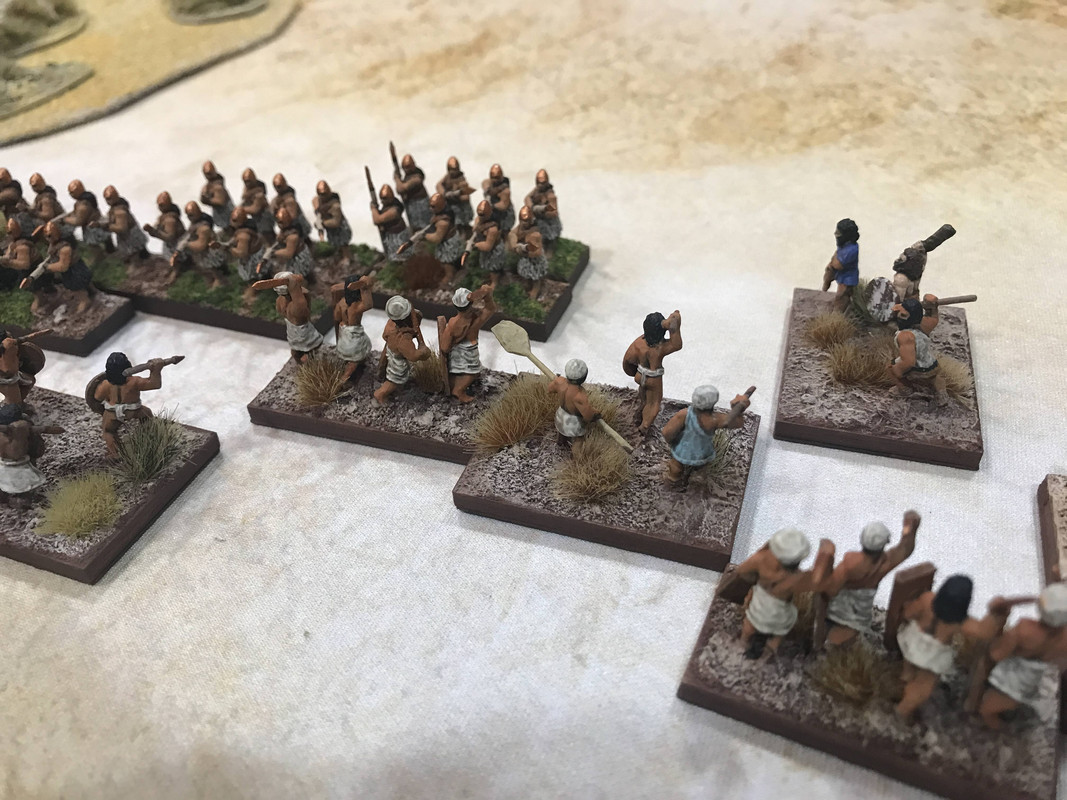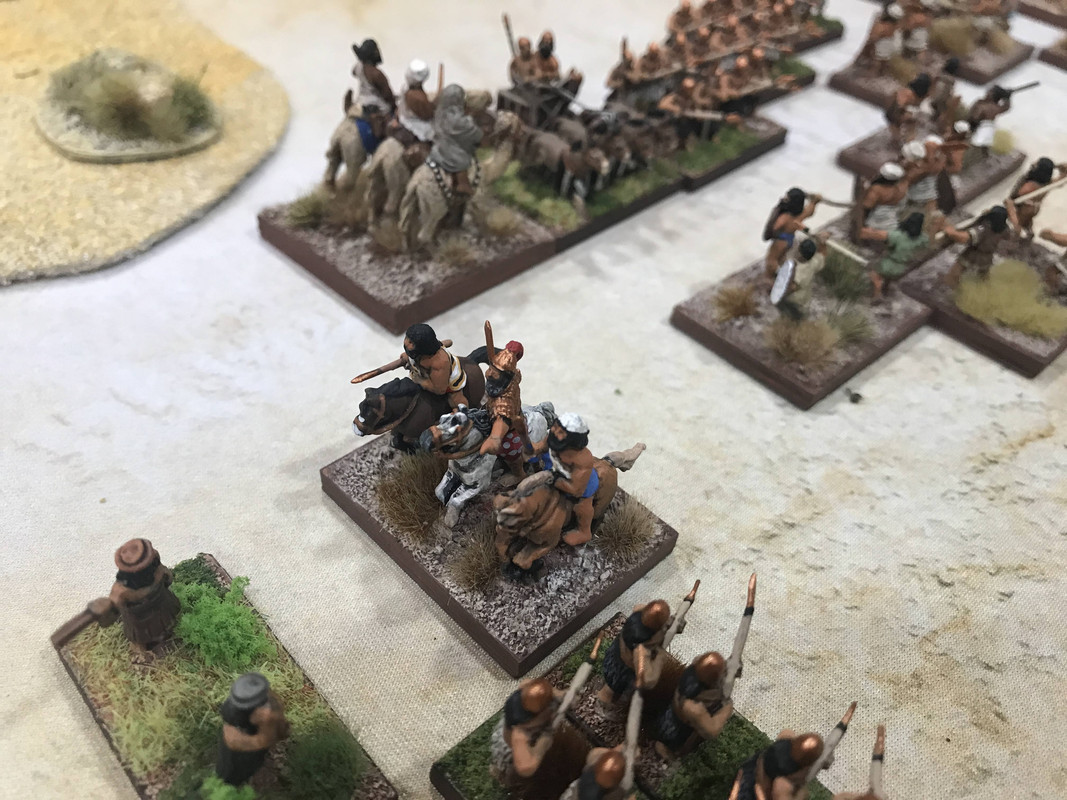The Akkadian Invasion of Dilmun, 2300 B.C.
Posted: Wed Nov 10, 2021 1:44 am
My son and I played Triumph! this week using the armies from the Dilmun, Yemeni Kingdoms, and Early Magan and Akkadian lists.
The army of Dilmun has one Bad Horse General, three Bad Horse (Light Camelry), four Raiders, one Skirmisher, and eight Rabble. They also had the Pack Trains battle card. My son commanded the forces of Dilmun.
The Akkadian forces were a Chariot General, ten stands of Pikes, one Raider, two Skirmishers, one Bow Levy, and one Rabble. I commanded the Akkadians.
Setting Up the Game
The Akkadians were the invaders and had the tactical advantage by a large margin. Dilmun had a choice of Arable or Dry terrain and chose Dry, hoping for more rough terrain that would favor his light troops and camelry. The Akkadians were able to modify the terrain score down to “2”, so there was only one patch of Rough terrain on the board. This was on the Akkadian left flank and played no role in the battle.
Deployment and Initial Plans
The Akkadians deployed with double ranked pike, with the lighter troops on each flank. The plan was to strike at the Raider stands with the massed Pikes, while holding off the enemy Camelry and Rabble on the flanks as a secondary effort. The General in his chariot remained just behind the Pikes so that he could respond to either flank. The stand of Bow Levy was detailed to guard the camp.
The army of Dilmun deployed with Raiders in the center, flanked by Camels and some light troops on the right and the General and his horsemen on their left. Large numbers of Rabble extended the left flank almost to the edge of the battlefield. The plan was to engage the Akkadian center while overwhelming the Akkadian right flank with Rabble. The Camelry and Skirmishers would go around the Akkadian left flank and attempt to capture the camp.

The Battle
The army of Dilmun moved forward, with their general prudently dropping behind the battle line in order to avoid the Akkadian pikemen. The Camelry and Skirmishers advanced quickly to threaten the Akkadian left flank.
The Akkadians also advanced steadily, shifting some Pike and the General to the left to deal with the Camelry. The battle then joined in earnest.
On the Akkadian left, the Camelry and Dilmun skirmishers attacked and destroyed the Akkadian light troops, but were in turn defeated by the Akkadian Pike detachment and or run down by the Akkadian General.
In the center, the double-ranked Akkadian pike engaged the Dilmun Raiders and broke through in short order, destroying several Raider stands.
The Dilmun Rabble were unable to make any significant advance on their flank and played little part in the battle.
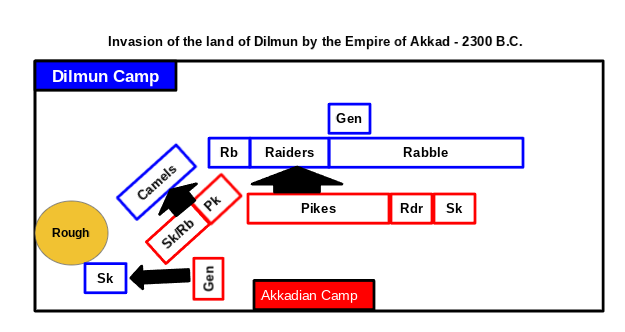
The Conclusion
The game ended with a victory for Akkad. Losses were Dilmun: 16 and Akkad: 5.
Photographs
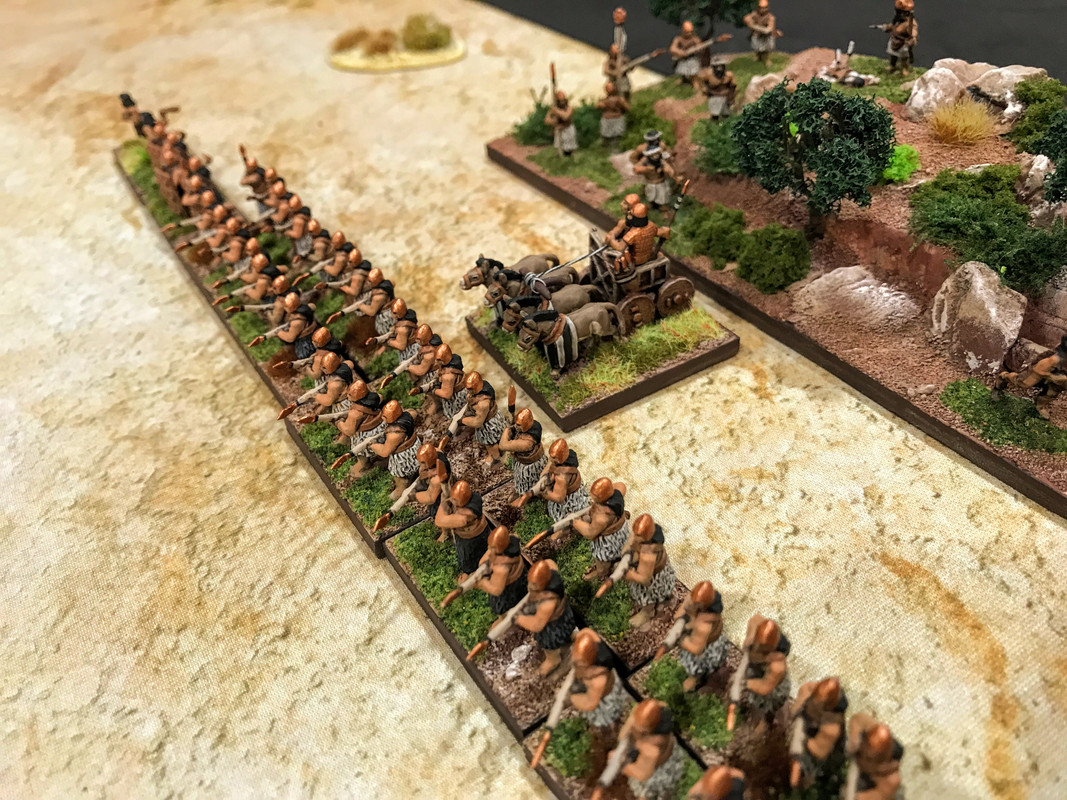
The Akkadian infantry fall in and prepare to advance.

In the distance the Akkadians can see the forces of Dilmun coming out to meet them.

The General commanding the forces of Dilmun alongside the most reliable troops, the city men.

Camel-riding men from Magan have been hired at great expense to defend the city.

The Akkadian General and some pikemen shift to the left to meet the mounted threat.
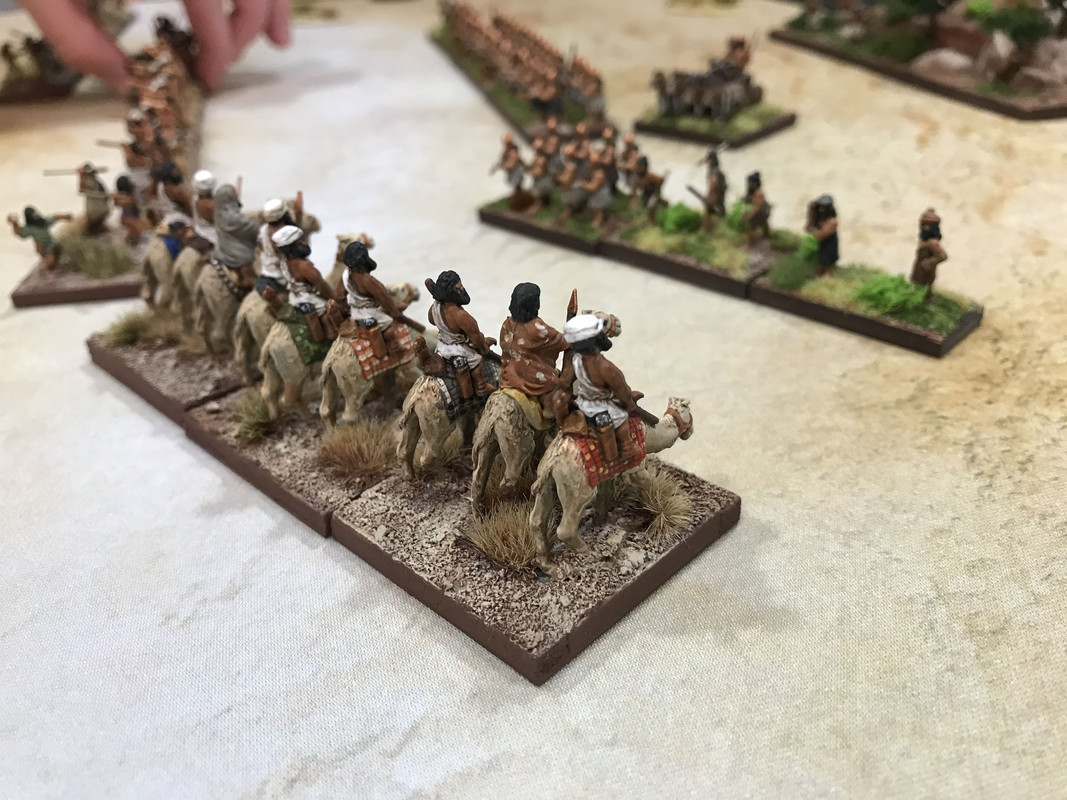
The men of Magan find the way to the Akkadian camp will not be so easy!

The rabble, mostly dock workers, sailors, and layabouts who have been drafted and indifferently equipped, make their way forward in a half-hearted fashion.

The troops on the Akkadian left flank, now much closer to the enemy, shout and prepare for the fight.
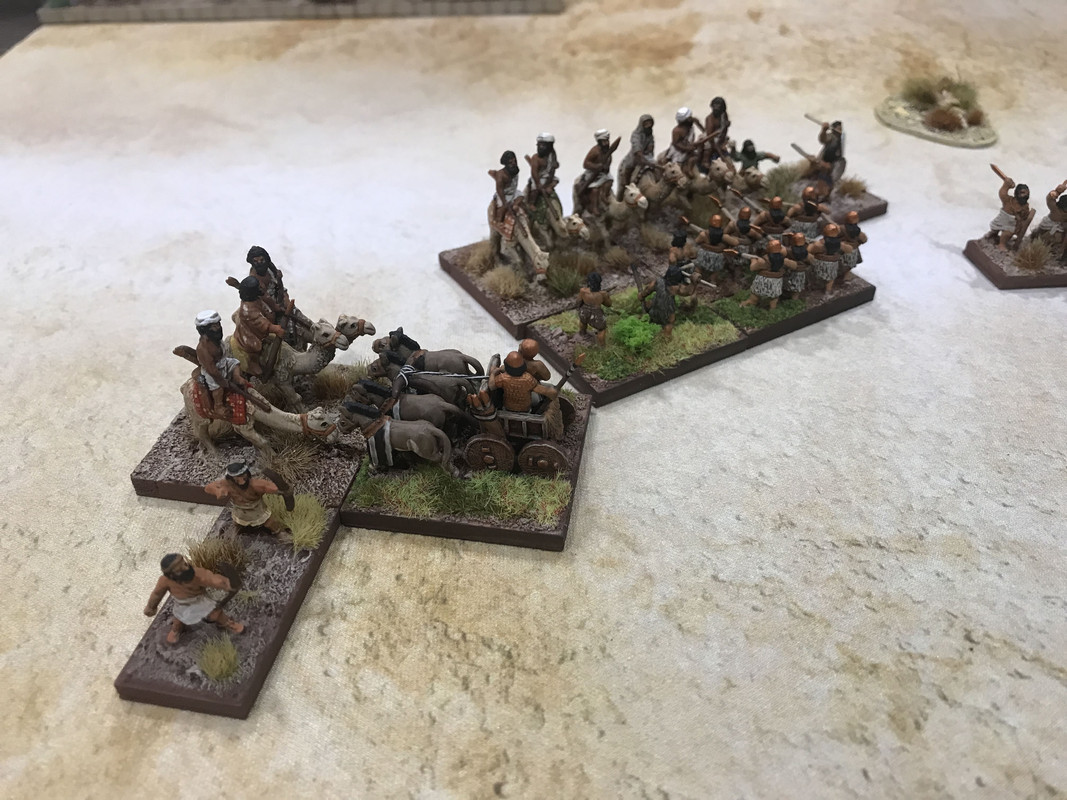
It seems a cloud has passed before the sun, which the Akkadian general declares is a sign from Anu, God of Heaven, that victory is certain. The battle commences.
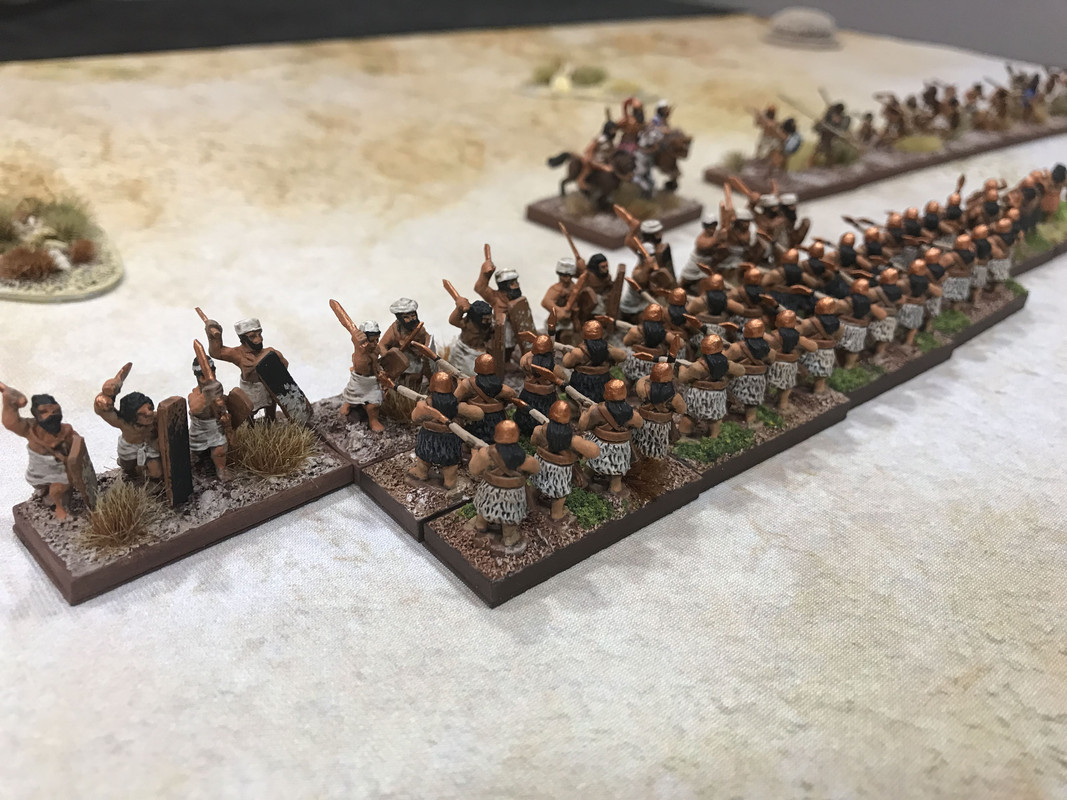
The city men and the Akkadian pikemen engage.
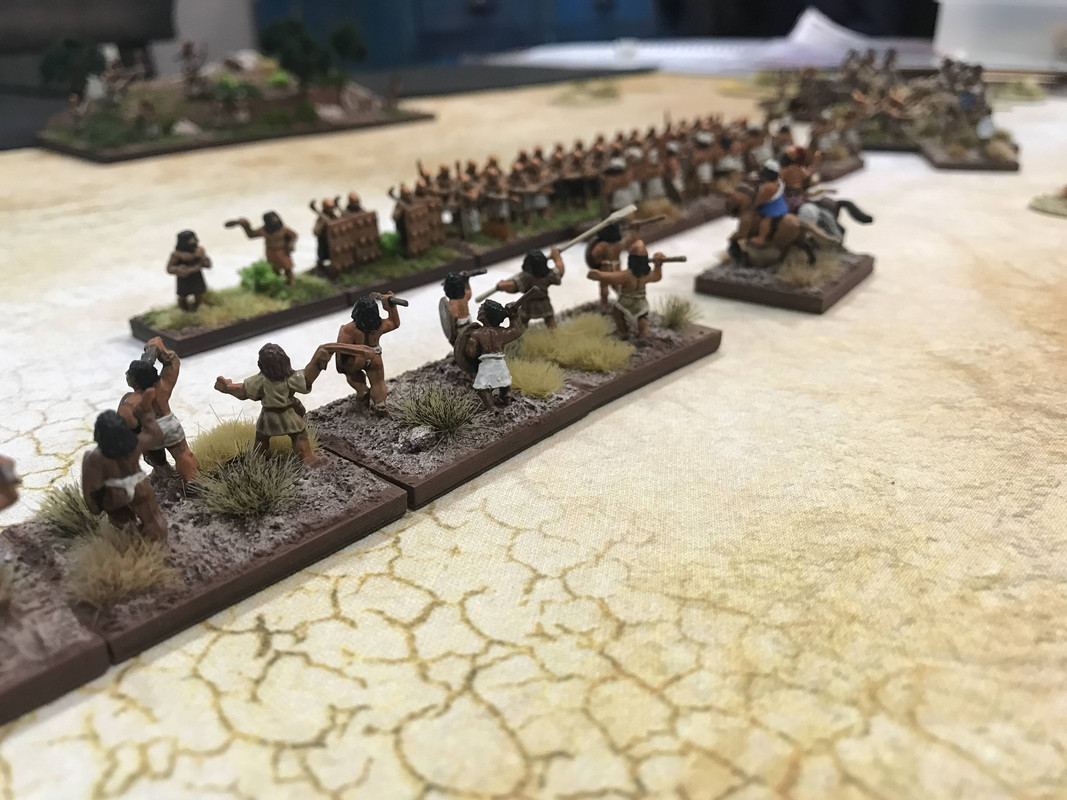
The rabble hesitate.

The camel riders of Magan are no match for the disciplined Akkadian pikemen.

The Dilmun general exhorts his men to hold but the dense masses of Akkadians cannot be resisted.
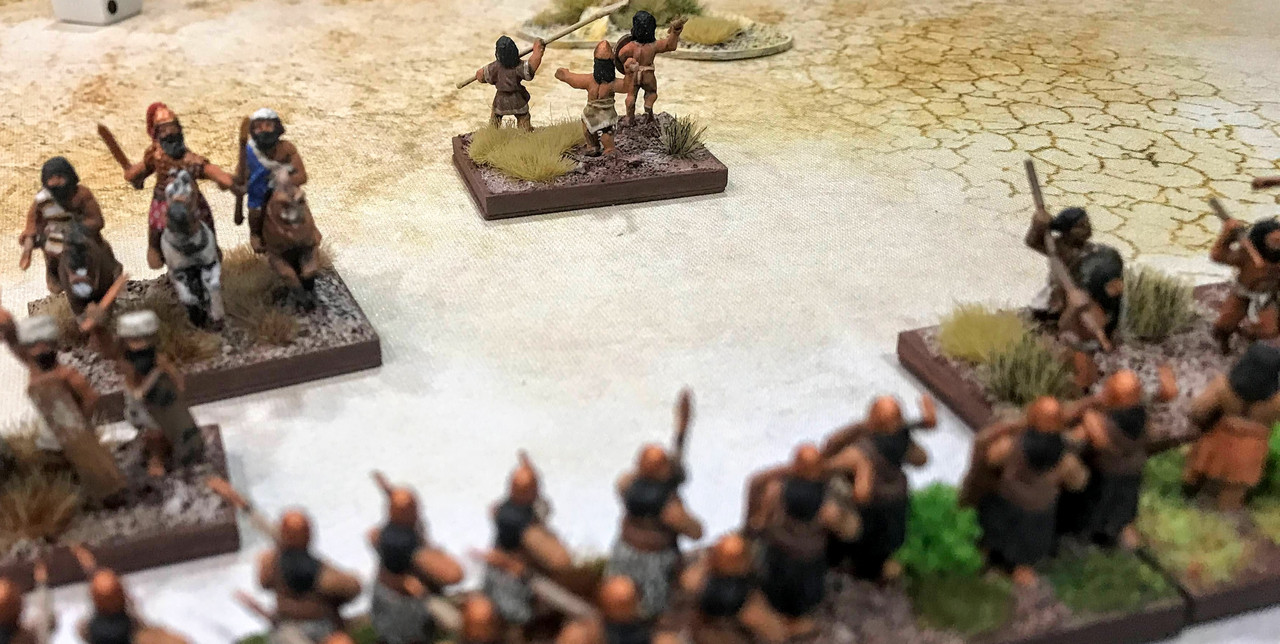
Some of the rabble tried to fight but soon fled back to the city, which only delays the harsh sentence the Akkadians pass on those who resist them.

The Dilmun center collapses and the battle ends.
The army of Dilmun has one Bad Horse General, three Bad Horse (Light Camelry), four Raiders, one Skirmisher, and eight Rabble. They also had the Pack Trains battle card. My son commanded the forces of Dilmun.
The Akkadian forces were a Chariot General, ten stands of Pikes, one Raider, two Skirmishers, one Bow Levy, and one Rabble. I commanded the Akkadians.
Setting Up the Game
The Akkadians were the invaders and had the tactical advantage by a large margin. Dilmun had a choice of Arable or Dry terrain and chose Dry, hoping for more rough terrain that would favor his light troops and camelry. The Akkadians were able to modify the terrain score down to “2”, so there was only one patch of Rough terrain on the board. This was on the Akkadian left flank and played no role in the battle.
Deployment and Initial Plans
The Akkadians deployed with double ranked pike, with the lighter troops on each flank. The plan was to strike at the Raider stands with the massed Pikes, while holding off the enemy Camelry and Rabble on the flanks as a secondary effort. The General in his chariot remained just behind the Pikes so that he could respond to either flank. The stand of Bow Levy was detailed to guard the camp.
The army of Dilmun deployed with Raiders in the center, flanked by Camels and some light troops on the right and the General and his horsemen on their left. Large numbers of Rabble extended the left flank almost to the edge of the battlefield. The plan was to engage the Akkadian center while overwhelming the Akkadian right flank with Rabble. The Camelry and Skirmishers would go around the Akkadian left flank and attempt to capture the camp.

The Battle
The army of Dilmun moved forward, with their general prudently dropping behind the battle line in order to avoid the Akkadian pikemen. The Camelry and Skirmishers advanced quickly to threaten the Akkadian left flank.
The Akkadians also advanced steadily, shifting some Pike and the General to the left to deal with the Camelry. The battle then joined in earnest.
On the Akkadian left, the Camelry and Dilmun skirmishers attacked and destroyed the Akkadian light troops, but were in turn defeated by the Akkadian Pike detachment and or run down by the Akkadian General.
In the center, the double-ranked Akkadian pike engaged the Dilmun Raiders and broke through in short order, destroying several Raider stands.
The Dilmun Rabble were unable to make any significant advance on their flank and played little part in the battle.

The Conclusion
The game ended with a victory for Akkad. Losses were Dilmun: 16 and Akkad: 5.
Photographs

The Akkadian infantry fall in and prepare to advance.

In the distance the Akkadians can see the forces of Dilmun coming out to meet them.

The General commanding the forces of Dilmun alongside the most reliable troops, the city men.

Camel-riding men from Magan have been hired at great expense to defend the city.

The Akkadian General and some pikemen shift to the left to meet the mounted threat.

The men of Magan find the way to the Akkadian camp will not be so easy!

The rabble, mostly dock workers, sailors, and layabouts who have been drafted and indifferently equipped, make their way forward in a half-hearted fashion.

The troops on the Akkadian left flank, now much closer to the enemy, shout and prepare for the fight.

It seems a cloud has passed before the sun, which the Akkadian general declares is a sign from Anu, God of Heaven, that victory is certain. The battle commences.

The city men and the Akkadian pikemen engage.

The rabble hesitate.

The camel riders of Magan are no match for the disciplined Akkadian pikemen.

The Dilmun general exhorts his men to hold but the dense masses of Akkadians cannot be resisted.

Some of the rabble tried to fight but soon fled back to the city, which only delays the harsh sentence the Akkadians pass on those who resist them.

The Dilmun center collapses and the battle ends.
